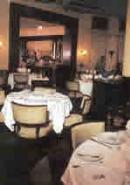El “Floridita”, the Birthplace of Daiquiri
The history of the bar began with the opening of a tavern on the corner of Obispo Street in Havana City (1818): “La Piña de Plata” at that time was a sort of a pleasant site for the enjoyment of a drink or for chatting with friends, after wandering around several commercial establishments.
In face of demolition, the owner promoted reforms in the old tavern. On the eve of its centennial, the affluence of American tourists was such that prompted the owner to change the name. Then El Floridita emerged, a name with which the establishment became worldwide famous.
The Birthplace of Daiquiri
From the cays of Florida came a man who turned into a legend. Thus in 1914, a Catalonian, Constantino Ribalaigua Vert worked there as a barman. His ethics, respect for the trade and knowledge granted an immediate category to the establishment. The place became in 1918 the property of Constante, the name by which people called Constantino, and rapidly gained credit for the excellence of its beverages and the treatment of the chosen personnel, over time it became a powerful magnet, an unequal attraction.
Around its varnished counter of precious wood, a large number of habitués used to gather, made up of a chosen group of personalities, many of whose names appear linked to the history of this bar. Nobody who visited Havana could escape from the special spell cast by the cathedral of daiquiri.
“Papa” in El Floridita
At the beginning of the 1930's, writer Ernest Hemingway, known by relatives and friends as “Papa,” began his frequent visits to Havana. One noon of the year 1939, he went through the doors of the bar and sat down in the first stool of the left corner of the counter. It was his usual seat. Now it has remained in front of him, facing his bust, unveiled in 1954 by friends and admirers.
An experienced taster, the writer discovered daiquiri at El Floridita and, according to Antonio Melián, his favorite barman, he said: “...O. K., but I rather like it without sugar and with double rum,” and thus emerged the special cocktail that bears his name “Papa Hemingway”.
Little by little, Ernest Hemingway became a part of the legendary bar. With his frequent visits raised the number of friends¾ Cubans and foreigners¾that he took to the place. Among the celebrities that accompanied him were: the duke and duchess of Windsor, Jean Paul Sartre, Errol Flynn, Gary Cooper (his dear friend), Dominguín, Tennesse Williams, Spencer Tracy, Rocky Marciano, Ava Gardner, Herbert Matthews... The photographs on the walls are proof of some of these gatherings, thus granting a special touch to the bar counter and the main hall. A photograph is also on the wall that couldn't be possibly missed, that of one of Hemingway's greatest admirers and with whom he also kept bonds of reciprocal friendship: Commander Fidel Castro Ruz.
Today's Floridita
The establishment celebrates its 50 years with new spirit and with a history that has the characteristic of a golden legend. At present, this mythical place continues its beautiful tradition linked to Havana: a sign that is a whole symbol, a bar counter made with precious woods, the famous mural that in three sequences presents a panoramic view of Havana Harbor and finally the ingenious arrow-shaped taburetes of forged iron.
In the counter where so many celebrities leaned, not less important figures also lean today in the bar as Jack Nickolson, Ornelia Mutti, Georgio Armani, Joaquín Sabina, Pablo Milanés; the actors of the Cuban film “Strawberry and Chocolate,” Naomi Campbell and many others that will make an endless long list. They all, Cubans and foreigners, personalities of world science and culture lead their steps toward the encounter with the birthplace of daiquiri.
El Floridita is still today El Floridita with a refined atmosphere and the sound of the guitars of its magnificent trios. Beyond doubt, this is a place that has an unmistakable personality. The visit will fill the traveler with memories, unique experiences, that will be passed from generation to generation to keep alive the secular magic of El Floridita throughout the years.
Note: · Around 1820, Havana was the most fortified square of the Americas. The population was encircled in a walled polyhedron for its preservation against pirate attacks. It was the so-called city within walls; but there was another Havana, found outside the walls, beyond the stoned wall, a double demographic life was then lived in the city.






































































